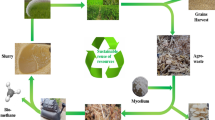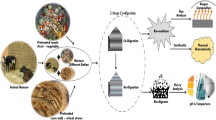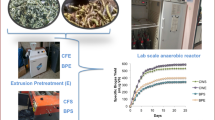Abstract
Municipal solid waste (MSW) is a good feedstock for biomethanation in biogas plants. As most of the solids in MSW digest away in a biogas plant (BGP), a large liquid effluent or biogas digester liquid (BDL) is left behind. This needs disposal. It is rich in N, P, K, and micronutrients. In this study, we examined its influence on mushroom growth and yields and its potential to supplement some nutrients on an otherwise nutrient-deficient mushroom feedstock such as Paddy Straw. Spraying BDL on mushroom (Pleurotus djamor) bags after spawn-run stage reduced the time required to reach various growth stages namely, pinhead and fruiting body formation as well as reduced time for mushroom harvest. The biological efficiency of the BDL sprayed mushroom bags was 558.33% and that of water (Control) sprayed bags was 288.30%. This is the highest BE achieved so far. Spraying of BDL could narrow the C:N ratio with “locked” nitrogen in the form of bacterial carcass which in turn leads to faster growth and higher yields of the mushroom. The substrate (paddy straw) was also analyzed for dry matter loss and degradation of organic fractions. Lignin degradation of 76.64% was achieved in controls against 66.90% loss in the BDL sprayed mushroom bags, at the end of three flushes. There was higher cellulose degradation in the BDL sprayed bags (88.03%) as compared to the control (77.84%). This softened biomass could be further composted or be directed towards bioethanol production.
Access provided by Autonomous University of Puebla. Download conference paper PDF
Similar content being viewed by others
Keywords
1 Introduction
India’s increasing population accompanied by rapid urbanization has led to increased municipal solid waste (MSW) production in metropolitan cities. Waste is generated from domestic households, restaurants and eateries, local factories, gardens, etc. This generated waste contains >80% decomposable substances [1]. If recycled efficiently, the locked nutrients can be returned to the soil. Currently, India has about 5 million biogas plants, and >90% run on cow dung as feedstock. An alternative feed for an urban biogas plant could be this MSW, agro-residues, leaf litter, etc. [2]. Organic fraction of the MSW (OFMSW) also has a good fraction of straw which is used as a packing material for fruits and vegetables. This forms a good feedstock for biogas production in modern biomass biogas plants. This straw waste could also be used a substrate to grow a variety of mushrooms (before and after anaerobic digestion) contributing significantly to sustainability.
Under anaerobic conditions in a BGP, microbes act on the organic fractions of MSW (cellulose, hemicellulose, and pectin) to convert it into biogas. MSW BGPs yield yields three outputs namely, (1) biogas (CH4 + CO2), (2) biogas digester residue (BDR), and (3) biogas digester liquid (BDL). Usually, lignin and some cellulosics are recalcitrant under anaerobic conditions as most microbes do not have the enzyme or access to degrade this complex lignin molecule. Yet, a part of this partial lignin breakdown product is leached into BDL. Basidiomycete fungi have enzymes that have the potential to degrade lignin into simpler sub-units [3, 4].
Unlike the typical straw feedstock, there is more easily accessible nitrogen in the form of bacterial protein in the biogas digester residue and is best suited for basidiomycete growth, a secondary colonizer. BDR can be converted to compost and vermi-composting but the economic returns are low as these are priced around ₹2–5/kg. On the other hand, converting BDR to mushrooms in combination with other substrates for the species Pleurotus sajor-caju is remunerative yielding 2–3 kg mushroom per kg of BDR accruing about ₹2–300 [5].
The BDL, on the other hand, has accessible nitrogen and phosphorous emerging from the original biomass or MSW feedstock fed to the biogas plant. In typical MSW plants installed across the country, biogas digester liquid is poorly used and most often consigned to the drains. This in addition to the partial breakdown products of lignin also has several long-chain volatile fatty acids (LCVFAs) that are known to repel insects. The release of micronutrients from breakdown of MSW and leaf litter biomass makes the BDL rich in, minerals and micronutrients. All these can stimulate basidiomycete growth if used alone on existing straw-based mushroom bags. We examine this possibility in this study [6]. Few additional uses of the BDL evolved are used as a pest repellent, for algal cultivation and as a fertilizer [ref]. In this study, the efficiency of P. djamor to pick up the locked nutrients from the BDL of a leaf biomass fed biogas plant is examined. Its growth pattern and biological efficiency are reported.
2 Materials and Methods
2.1 Materials and BDL
Ready-to-use fruit bags were used in this study and were bought from Biocentre, Bangalore. The substrate (paddy straw) and spawn were mixed in the ratio 10:1. Once inoculated, these bags were incubated in the dark for 25 days until the mycelia were well formed (spawn-run) and uniformly distributed all over the surface. After this stage, small holes were made around the bag to facilitate pinhead formation and consequent emerging of fruiting bodies allowing easy harvesting of mushrooms (Fig. 1). Four bags were sprayed with 100 mL water each, every day (Control) and six bags was sprayed with 100 mL BDL every day. The BDL was taken from the outlet of a plug flow reactor fed with a leafy biomass. It was filtered using a 50 μm mesh and maintained frozen for future use.
2.2 Sampling of Substrate
Ten grams of the residual straw samples were collected from various bags at regular intervals until the end of the third flush of mushrooms (~30 days) and dried rapidly. The dried straw was powdered and sieved through a 50 μm mesh and stored for further analysis. A detailed analysis of the different organic fractions in the substrate was done using a sequential extraction protocol [7].
3 Results and Discussion
3.1 Mushroom Yields
The mushroom bags supplemented with BDL was found to have faster growth in terms of the time at which pinhead formation was observed, fruiting body became visible as well as the first flush could be recovered and carried out with water sprayed bags as control (Fig. 2). The pinhead formation occurred in 32 days after the inoculation of the spawn for BDL sprayed bags as opposed to 36 days in the water sprayed bags. The time required for fruiting bodies to emerge and enlarge was shortened from 42 days in control to 37 days with BDL sprayed bags. Spraying of BDL could narrow the C:N ratio of the substrate. BDL was found to have locked organic nitrogen which leads to faster growth and higher yields of mushrooms. The first flush of mushrooms in the BDL sprayed bags was seen on 46 days as opposed to 52d in the case of water sprayed controls. The maximum biological efficiency for the control bags was 288%, and that of BDL sprayed bags was found to be 558%. The maximum efficiency till date was reported for Hypsigus ulmarius, which was 437% [8].
3.2 Dry Matter and Organic Fractions Retained
The powdered substrate samples were analyzed at regular intervals for dry matter loss and its organic constituents over the experiment duration. The substrate in the BDL sprayed bags showed 40% loss on 34d itself, after which, it showed a gradual decline to a final 75% at the end of the third flush (60d). The control bags also displayed a similar degradation pattern, showing a loss 70% dry matter at the end of Day 60 (Fig. 3). One may expect higher yields of mushroom to correspond to higher dry matter loss, but this was not the case with P. djamor. In other species such as P. florida, the DM loss increased with BDL spray and with no differences with H. ulmarius [6, 8].
Calculating the individual components of biomass retained at various stages of decomposition gives a better understanding of the components and its rate of degradation (Fig. 4). Lignin, thought to be recalcitrant in most cases, showed significant degradation or loss with degradation time. Generally, most studies indicate that lignin component of the biomass is recalcitrant under anaerobic conditions and is not decomposable or convertible to biogas. BDL appears to have significant content of lignin breakdown products (CST, unpublished study). In the control bags, there was 76.64% degradation while around 66.90% lignin was lost in the BDL sprayed bags at the end of three flushes. There was higher cellulose degradation in the BDL sprayed bags (88.03%) as compared to the control (77.84%). Hemicellulose degradation was about the same (~90%) in both the setups. This softened biomass could be composted or even employed for bioethanol production [9].
4 Conclusion
Straws, leaf litter, and bagasse form a significant part of MSW and are best processed by biomethanation so as to provide economic output (biogas) and compost. Biogas plants lose a lot of valuable components in the biogas digester liquid (BDL) and are rarely tapped as an economic output. Using BDL as a supplement for growing P. djamor not only reduces the harvest time in terms of pinhead formation, fruiting body, and collection, it also increases the yields of the mushroom by nearly 50% over unsprayed control in this experimental setup. This has not been reported before and forms a new value addition mechanism for MSW biogas plants. Spraying of BDL could narrow the C:N ratio of the mushroom substrate leading to faster growth and higher yields of the mushroom.
References
Chanakya HN, Malayil S (2013) Techno-economic potential for value added products from digestion of urban solid wastes and rural residues. Dyn Biochem Process Biotechnol Mol Biol 6(special Issue 2):38–42
Chanakya HN, Malayil S (2012) Anaerobic digestion for bioenergy from agro-residues and other solid wastes—an overview of science, technology and sustainability. J Indian Inst Sci 92(1):111–144
Hasewaga H, Ichinohe T, Ainai A, Nakamura T, Akiyama Y, Maeyama JI, Odagiri T, Chiba J et al (2010) Induction of cross-protective immunity against influenza A virus H5N1 by an intranasal vaccine with extracts of mushroom mycelia. J Med Virol 82(1):128–137
Barbosa Raposo NR, Zimmermann Franco DC, Gonçalves de Carvalho GS, Rocha PR, da Silva Teixeira R, Da Silva AD (2012) Inhibitory effects of resveratrol analogs on mushroom tyrosinase activity. Molecules 17(10):11816–11825
Ganguli NK, Chanakya HN (1994) Mushroom cultivation on spent biomass from biogas plant. Curr Sci India 66:70–73
Chanakya HN, Malayil S, Vijayalakshmi C (2015) Cultivation of Pleurotus spp. on a combination of anaerobically digested plant material and various agro-residues. Energy Sustain Dev 27:84–92
Chesson A (1978) Maceration of linen flax under anaerobic conditions. J Appl Bacteriol 45:219–230
Malayil S, Chanakya HN, Ashwath R, Suresh H (2017) Biogas digester liquid as a supplement for higher yields of Hypsizgus ulmarius. Environ. Technol. Innov. 8:269–281
Vikram S, Binod P, Sindhu R, Singhania RR, Devi L, Nagalakshmi S, Pandey A et al (2010) Bioethanol production from rice straw: an overview. Biores Technol 101(13):4767–4774
Yoswathana N, Phuriphipat P, Treyawutthiwat P, Eshtiaghi MN (2010) Bioethanol production from rice straw. Energy Res J 1(1):26
Author information
Authors and Affiliations
Corresponding author
Editor information
Editors and Affiliations
Rights and permissions
Copyright information
© 2019 Springer Nature Singapore Pte Ltd.
About this paper
Cite this paper
Suresh, H., Chanakya, H.N., Malayil, S. (2019). Creating Value Addition for MSW Biogas Plants: Increasing Mushroom Yields with Biogas Plant Digester Liquid. In: Ghosh, S. (eds) Waste Valorisation and Recycling. Springer, Singapore. https://doi.org/10.1007/978-981-13-2784-1_42
Download citation
DOI: https://doi.org/10.1007/978-981-13-2784-1_42
Published:
Publisher Name: Springer, Singapore
Print ISBN: 978-981-13-2783-4
Online ISBN: 978-981-13-2784-1
eBook Packages: Earth and Environmental ScienceEarth and Environmental Science (R0)








